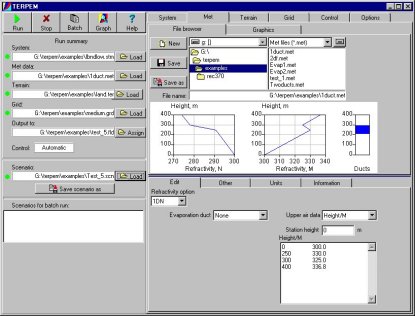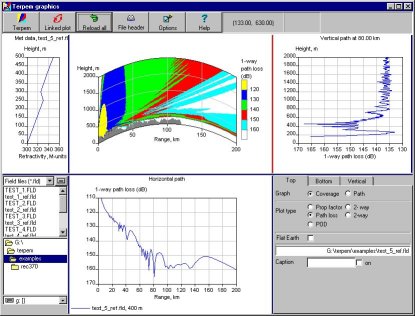
|
|
|||||||||||
TERPEM PACKAGE
The TERPEM propagation package provides a powerful tool for forecasting and analysis of refraction, ducting and terrain effects on radiowave links. It is based on state-of-the-art hybrid models combining parabolic equation and ray-trace techniques. The TERPEM package is the result of on-going algorithm and software development that began in 1989 with the release of PCPEM.
|
Computer platform: |
PC with Windows 95, 98 or NT, 100 MHz or higher Pentium processor and at least 32 Mbytes of RAM. |
|
Frequency range: |
30 MHz to 100 GHz. |
|
TERPEM package components: |
interface for specification of input parameters |
meteorological module |
|
propagation engine |
|
coverage diagrams |
|
path loss plots |
TERPEM interface screen
Input scenarios including system and environmental parameters are specified via a Windows interface. The propagation engine computes path loss arrays on a user-specified range/height grid.

Typical TERPEM computation times on 200 MHz Pentium
The TERPEM propagation engine uses hybrid techniques that combine the accuracy of the full-wave parabolic equation method with the speed of ray-trace methods. This leads to rapid computation times, even for large range-height domains:
|
Antenna height |
Frequency |
Range/height domain |
Environment |
Timings |
|
25 m |
3 GHz |
250 km by 2500 m |
evaporation duct/sea |
2 s |
|
25 m |
10 GHz |
250 km by 2500 m |
evaporation duct/sea |
5 s |
|
10000 m |
3 GHz |
500 km by 10000 m |
multiple ducts/mountains |
2 min |
|
1000 m |
10 GHz |
250 km by 2500 m |
elevated duct/coastal |
1 min |
TGRAPH: the TERPEM postprocessor
TGRAPH provides postprocessing graphics and facilities for ASCII output. Options include coverage diagrams and path loss graphs along vertical, horizontal or user-defined trajectories. Alternatively users can write their own analysis software accessing TERPEM output files, using the format description given in the TERPEM documentation.

Capabilities of TERPEM propagation models
Additional TERPEM modules
Customised versions of TERPEM
As well as the "off-the-shelf" TERPEM package described above, TERPEM can also be integrated into larger software suites. For example TERPEM provides the propagation backbone for EEMS (Environmental Electromagnetic Modelling System), the UK Royal Navy operational replacement for IREPS. TERPEM has also been incorporated in Unix-based propagation packages.
The TERPEM propagation engine can be tailored to your particular needs. For example, versions have been developed for customers that include the effects of clutter, and that predict phase effects (for synthetic aperture array applications).
If you have an application that you would like to discuss, please
contact us.